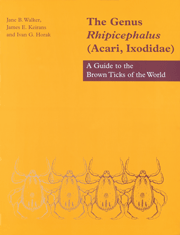Book contents
- Frontmatter
- Contents
- Acknowledgements
- 1 Introduction
- 2 Relationships of the ticks (Ixodida) and definition of the genus Rhipicephalus
- 3 Format for the accounts of individual species
- 4 Glossary
- 5 Rhipicephalus species names of the world
- 6 Rhipicephalus species occurring in the Afrotropical region
- 7 Accounts of individual species occurring in the Afrotropical region. pages 59 to 277
- Accounts of individual species occurring in the Afrotropical region. pages 278 to 490
- 8 Host/parasite list for the Afrotropical Rhipicephalus species
- 9 Rhipicephalus species occurring outside the Afrotropical region
- 10 Accounts of individual species occurring outside the Afrotropical region
- 11 Host/parasite list for the non-Afrotropical Rhipicephalus species
- 12 Species groups based on the immature stages
- 13 The transmission of tick-borne diseases of animals and humans by Rhipicephalus species
- Index
2 - Relationships of the ticks (Ixodida) and definition of the genus Rhipicephalus
Published online by Cambridge University Press: 05 November 2011
- Frontmatter
- Contents
- Acknowledgements
- 1 Introduction
- 2 Relationships of the ticks (Ixodida) and definition of the genus Rhipicephalus
- 3 Format for the accounts of individual species
- 4 Glossary
- 5 Rhipicephalus species names of the world
- 6 Rhipicephalus species occurring in the Afrotropical region
- 7 Accounts of individual species occurring in the Afrotropical region. pages 59 to 277
- Accounts of individual species occurring in the Afrotropical region. pages 278 to 490
- 8 Host/parasite list for the Afrotropical Rhipicephalus species
- 9 Rhipicephalus species occurring outside the Afrotropical region
- 10 Accounts of individual species occurring outside the Afrotropical region
- 11 Host/parasite list for the non-Afrotropical Rhipicephalus species
- 12 Species groups based on the immature stages
- 13 The transmission of tick-borne diseases of animals and humans by Rhipicephalus species
- Index
Summary
Ticks are all obligate blood-feeding parasites of terrestrial vertebrates at some stage of their life cycle. Many species are of considerable interest and importance as vectors of a wide variety of pathogens to both humans and animals.
They are members of the phylum Arthropoda, the jointed-legged animals. Although often referred to as insects, whose adults have six legs, they are in fact members of the class Arachnida. This class, whose adults have eight legs, includes spiders and scorpions as well as the order Acari, a large and diverse group to which the ticks and mites belong. Within the Acari the suborder Ixodida encompasses the three families of ticks, the Argasidae, Nuttalliellidae and Ixodidae. The systematics of the Ixodida were reviewed recently by Keirans (1992).
Members of the family Ixodidae, to which the genus Rhipicephalus belongs, are characterized by having a hard sclerotized scutum. This completely covers the dorsal surface of the body in the males but is merely a smaller shield just behind the capitulum in the females and immature stages. The mouthparts of all these ticks are anterior in position; their eyes, when present, are near the lateral margin of the scutum, and their spiracles, which are large, are located behind coxae IV. This combination of characters readily distinguishes ixodid ticks from species in the Nuttalliellidae and the Argasidae. Members of both the latter families lack a hard sclerotized scutum: the main feature characterizing them is the leathery integument that covers their bodies.
- Type
- Chapter
- Information
- The Genus Rhipicephalus (Acari, Ixodidae)A Guide to the Brown Ticks of the World, pp. 3 - 4Publisher: Cambridge University PressPrint publication year: 2000



